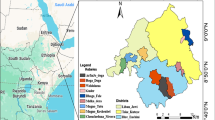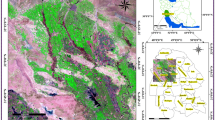Abstract
Vegetation indices are used in precision agriculture to estimate crop aboveground biomass (AGB) and, in turn, to quantify crop needs. However, crop species and development stage affect vegetation indices limiting the setup of generalized models for AGB estimation. Some approaches to overcome this issue have combined vegetation indices and structural crop properties such as crop height. However, only a few studies have considered different herbaceous crops like forages and cover crops. A 2-year field experiment was carried out on five winter cover crops with different habits at a high cover fraction (on average 93%) to study if combining vegetation indices, crop height and the fraction of soil covered by the crop could improve AGB estimation. Seven vegetation indices, crop height and cover fraction were derived from UAV-multispectral images. Species-specific and global (including all species) regression models were built and tested through cross-validation (CV). Green-based indices were the best estimators of AGB (RCV2 = 0.56–0.93, normalized root mean square error in CV nRMSECV = 26–38%) of the five species, separately. A global linear model using crop height alone, provided good results (RCV2 = 0.57, nRMSECV = 42%). Also, stepwise multiple regression was used to get a global model with crop height and five vegetation indices (RCV2 = 0.75, nRMSECV = 31%). Finally, a model was proposed where AGB was estimated by a vegetation index until plants covered 97% of soil or its height was shorter than 125 mm and by crop height for vegetation taller than 125 mm. The promising results (RCV2 = 0.65, nRMSECV = 36%) suggested the possibility of increasing AGB estimation by considering both vegetation indices and structural crop properties.





Similar content being viewed by others
Data availability
The datasets generated during and analysed during the current study are available from the corresponding author on reasonable request.
References
Azimi, S., Kaur, T., & Gandhi, T. K. (2021). A deep learning approach to measure stress level in plants due to nitrogen deficiency. Measurement, 173, 108650. https://doi.org/10.1016/j.measurement.2020.108650
Bendig, J., Bolten, A., Bennertz, S., Broscheit, J., Eichfuss, S., & Bareth, G. (2014). Estimating biomass of barley using crop surface models (CSMs) derived from UAV-based RGB imaging. Remote Sensing, 6, 10395–10412. https://doi.org/10.3390/rs61110395
Bendig, J., Kang, Y., Aasen, H., Bolten, A., Bennertz, S., Broscheit, J., Gnyp, M. L., & Bareth, G. (2015). Combining UAV-based plant height from crop surface models, visible and near infrared vegetation indices for biomass monitoring in barley. International Journal of Applied Earth Observation and Geoinformation, 39, 79–87. https://doi.org/10.1016/j.jag.2015.02.012
Calou, V. B., Teixeira, A. D. S., Moreira, L. C., da Rocha Neto, O. C., & da Silva, J. A. (2019). Estimation of maize biomass using unmanned aerial vehicles. Engenharia Agrícola, 39, 744–752. https://doi.org/10.1590/1809-4430-eng.agric.v39n6p744-752/2019
Cao, H., Gu, X., Wei, X., Yu, T., & Zhang, H. (2020). Lookup table approach for radiometric calibration of miniaturized multispectral camera mounted on an unmanned aerial vehicle. Remote Sensing, 12, 4012. https://doi.org/10.3390/rs12244012
Corti, M., Cavalli, D., Cabassi, G., Gallina, P. M., & Bechini, L. (2018). Does remote and proximal optical sensing successfully estimate maize variables? A review. European Journal of Agronomy, 99, 37–50. https://doi.org/10.1016/j.eja.2018.06.008
Corti, M., Gallina, P. M., Cavalli, D., & Cabassi, G. (2017). Hyperspectral imaging of spinach canopy under combined water and nitrogen stress to estimate biomass, water and nitrogen content. Biosystems Engineering, 158, 38–50. https://doi.org/10.1016/j.biosystemseng.2017.03.006
Corti, M., Gallina, P. M., Cavalli, D., Ortuani, B., Cabassi, G., Cola, G., Vigoni, A., Degano, L., & Bregaglio, S. (2020). Evaluation of in-season management zones from high-resolution soil and plant sensors. Agronomy, 10, 1124. https://doi.org/10.3390/agronomy10081124
Deery, D., JimenezBerni, J., Jones, H., Sirault, X., & Furbank, R. (2014). Proximal remote sensing buggies and potential applications for field-based phenotyping. Agronomy, 4, 349–379. https://doi.org/10.3390/agronomy4030349
Farooque, A. A., Chang, Y. K., Zaman, Q. U., Groulx, D., Schumann, A. W., & Esau, T. J. (2013). Performance evaluation of multiple ground based sensors mounted on a commercial wild blueberry harvester to sense plant height, fruit yield and topographic features in real-time. Computers and Electronics in Agriculture, 91, 135–144. https://doi.org/10.1016/j.compag.2012.12.006
Freeman, K. W., Girma, K., Arnall, D. B., Mullen, R. W., Martin, K. L., Teal, R. K., & Raun, W. R. (2007). By-plant prediction of corn forage biomass and nitrogen uptake at various growth stages using remote sensing and plant height. Agronomy Journal, 99, 530–536. https://doi.org/10.2134/agronj2006.0135
Goel, N. S., & Qin, W. (1994). Influences of canopy architecture on relationships between various vegetation indices and LAI and FPAR: A computer simulation. Remote Sensing Reviews, 10, 309–347. https://doi.org/10.1080/02757259409532252
Gu, Y., Wylie, B. K., Howard, D. M., Phuyal, K. P., & Ji, L. (2013). NDVI saturation adjustment: A new approach for improving cropland performance estimates in the Greater Platte River Basin, USA. Ecological Indicators, 30, 1–6. https://doi.org/10.1016/j.ecolind.2013.01.041
Haboudane, D., Miller, J. R., Tremblay, N., ZarcoTejada, P. J., & Dextraze, L. (2002). Integrated narrowband vegetation indices for prediction of crop chlorophyll content for application to precision agriculture. Remote Sensing of Environment, 81, 416–426. https://doi.org/10.1016/S00344257(02)000184
Huete, A. R., Liu, H., & van Leeuwen, W. J. (1997). The use of vegetation indices in forested regions: Issues of linearity and saturation. In IEEE International Geoscience and Remote Sensing Symposium Proceedings, 4, 1966–1968. https://doi.org/10.1109/IGARSS.1997.609169
Jackson, R. D., & Huete, A. R. (1991). Interpreting vegetation indices. Preventive Veterinary Medicine, 11, 185. https://doi.org/10.1016/S0167-5877(05)80004-2
Jimenez-Berni, J. A., Deery, D. M., Rozas-Larraondo, P., Condon, A. T. G., Rebetzke, G. J., James, R. A., Bovill, W. D., Furbank, R. T., & Sirault, X. R. R. (2018). High-throughput determination of plant height, ground cover and aboveground biomass in wheat with LiDAR. Frontiers in Plant Science, 9, 237. https://doi.org/10.3389/fpls.2018.00237
Kuhn, M., 2021. caret: Classification and Regression Training. R package version 6.0–90. Retrieved October, 2021, from https://CRAN.R-project.org/package=caret
Lumley, T., based on Fortran code by Alan Miller, 2020. leaps: Regression Subset Selection. R package version 3.1. Retrieved January, 2020, from https://CRAN.R-project.org/package=leaps
Madec, S., Baret, F., de Solan, B., Thomas, S., Dutartre, D., Jezequel, S., Hemmerlé, M., Colombeau, G., & Comar, A. (2017). High-throughput phenotyping of plant height: comparing unmanned aerial vehicles and ground LiDAR estimates. Frontiers in Plant Science, 8, 2002. https://doi.org/10.3389/fpls.2017.02002
Marshall, M., & Thenkabail, P. (2015). Developing in situ non-destructive estimates of crop biomass to address issues of scale in remote sensing. Remote Sensing, 7, 808–835. https://doi.org/10.3390/rs70100808
Muggeo, V. M. (2008). Segmented: An R package to fit regression models with broken-line relationships. R News, 8, 20–25.
MuñozHuerta, R., GuevaraGonzalez, R., ContrerasMedina, L., TorresPacheco, I., PradoOlivarez, J., & OcampoVelazquez, R. (2013). A review of methods for sensing the nitrogen status in plants: Advantages, disadvantages and recent advances. Sensors, 13, 10823–10843. https://doi.org/10.3390/s130810823
Mutanga, O., & Skidmore, A. K. (2004). Narrow band vegetation indices overcome the saturation problem in biomass estimation. International Journal of Remote Sensing, 25, 3999–4014. https://doi.org/10.1080/01431160310001654923
Noh, H., Zhang, Q., Han, S., Shin, B., & Reum, D. (2005). Dynamic calibration and image segmentation methods for multispectral imaging crop nitrogen deficiency sensors. Transactions American Society of Agricultural Engineers, 48, 393–401. https://doi.org/10.13031/2013.17933
Otsu, N. (1975). A threshold selection method from gray-level histograms. Automatica, 11, 23–27. https://doi.org/10.1109/TSMC.1979.4310076
Pauly, K., 2016. Towards calibrated vegetation indices from UAS-derived orthomosaics. In Proceedings of the 13th International Conference on Precision Agriculture. Retrieved August, 2022, from https://www.ispag.org/proceedings/?action=year_abstracts
Pinter, P. J., Jr., Hatfield, J. L., Schepers, J. S., Barnes, E. M., Moran, M. S., Daughtry, C. S., & Upchurch, D. R. (2003). Remote sensing for crop management. Photogrammetric Engineering & Remote Sensing, 69, 647–664. https://doi.org/10.14358/PERS.69.6.647
Poley, L. G., & McDermid, G. J. (2020). A systematic review of the factors influencing the estimation of vegetation aboveground biomass using unmanned aerial systems. Remote Sensing, 12, 1052. https://doi.org/10.3390/rs12071052
Prabhakara, K., Hively, W. D., & McCarty, G. W. (2015). Evaluating the relationship between biomass, percent groundcover and remote sensing indices across six winter cover crop fields in Maryland, United States. International Journal of Applied Earth Observation and Geoinformation, 39, 88–102. https://doi.org/10.1016/j.jag.2015.03.002
QGIS.org, 2020. QGIS Geographic Information System. QGIS Association. Retrieved January, 2020, from http://www.qgis.org
R Core Team. (2019). R: A language and environment for statistical computing. Vienna: R Foundation for Statistical Computing.
Rasmussen, J., Ntakos, G., Nielsen, J., Svensgaard, J., Poulsen, R. N., & Christensen, S. (2016). Are vegetation indices derived from consumer-grade cameras mounted on UAVs sufficiently reliable for assessing experimental plots? European Journal of Agronomy, 74, 75–92. https://doi.org/10.1016/j.eja.2015.11.026
Revelle W (2020). psych: Procedures for Psychological, Psychometric and Personality Research. Northwestern University, Evanston, Illinois, USA. R package version 2.0.9, Retrieved September, 2021, from https://cran.r-project.org/web/packages/psych/
Roth, L., & Streit, B. (2018). Predicting cover crop biomass by lightweight UAS-based RGB and NIR photography: An applied photogrammetric approach. Precision Agriculture, 19, 93–114. https://doi.org/10.1007/s11119-017-9501-1
Sharma, L. K., Bu, H., Franzen, D. W., & Denton, A. (2016). Use of corn height measured with an acoustic sensor improves yield estimation with ground based active optical sensors. Computers and Electronics in Agriculture, 124, 254–262. https://doi.org/10.1016/j.compag.2016.04.016
Shrivastava, A., & Gupta, V. B. (2011). Methods for the determination of limit of detection and limit of quantitation of the analytical methods. Chronicles of Young Scientists, 2, 21. https://doi.org/10.4103/2229-5186.79345
Thenkabail, P. S., Smith, R. B., & De Pauw, E. (2000). Hyperspectral vegetation indices and their relationships with agricultural crop characteristics. Remote Sensing of Environment, 71, 158–182. https://doi.org/10.1016/S0034-4257(99)00067-X
Tilly, N., Aasen, H., & Bareth, G. (2015). Fusion of plant height and vegetation indices for the estimation of barley biomass. Remote Sensing, 7, 11449–11480.
Vincini, M., Frazzi, E., D’Alessio, P., 2006. Angular dependence of maize and sugar beet VIs from directional CHRIS/Proba data. In Proceedings of 4th ESA CHRIS PROBA Workshop, pp. 19–21. Retrieved August, 2022, from https://www.researchgate.net/publication/228413259_Angular_dependence_of_maize_and_sugar_beet_VIs_from_directional_CHRISProba_data
Wang, C., Feng, M. C., Yang, W. D., Ding, G. W., Sun, H., Liang, Z. Y., Xie, Y. K., & Qiao, X. X. (2016). Impact of spectral saturation on leaf area index and aboveground biomass estimation of winter wheat. Spectroscopy Letters, 49, 241–248. https://doi.org/10.1080/00387010.2015.1133652
Wickham, H. (2016). ggplot2: Elegant graphics for data analysis. Springer-Verlag.
Wiering, N. P., Ehlke, N. J., & Sheaffer, C. C. (2019). Lidar and RGB image analysis to predict hairy vetch biomass in breeding nurseries. The Plant Phenome Journal, 2, 190003. https://doi.org/10.2135/tppj2019.02.0003
Acknowledgements
The experiment was part of the CoCrop project (CUP E86G16002800007), funded by the European Agricultural Fund for Rural Development (EAFRD) under Measure 16, Operation 16.2.01, of the Rural Development Program 2014-2020 of the Lombardy Region (Italy). The authors thank the students and collaborators who helped in field work and sampling campaigns: Fabio Introzzi, Roberto Fuccella, Riccardo Asti, Matteo Bosso, Federico Concas, Michele Croci, Stefano Virgadaula, Davide Mapelli, Paolo Pozzi, Pietro Zarpellon, Riccardo Beretta. Thanks to Virginia Fassa for her help in map visualization.
Author information
Authors and Affiliations
Corresponding author
Ethics declarations
Conflict of interest
The authors declare that they have no conflict of interest.
Additional information
Publisher's Note
Springer Nature remains neutral with regard to jurisdictional claims in published maps and institutional affiliations.
Supplementary Information
Below is the link to the electronic supplementary material.
Rights and permissions
Springer Nature or its licensor holds exclusive rights to this article under a publishing agreement with the author(s) or other rightsholder(s); author self-archiving of the accepted manuscript version of this article is solely governed by the terms of such publishing agreement and applicable law.
About this article
Cite this article
Corti, M., Cavalli, D., Cabassi, G. et al. Improved estimation of herbaceous crop aboveground biomass using UAV-derived crop height combined with vegetation indices. Precision Agric 24, 587–606 (2023). https://doi.org/10.1007/s11119-022-09960-w
Accepted:
Published:
Issue Date:
DOI: https://doi.org/10.1007/s11119-022-09960-w




